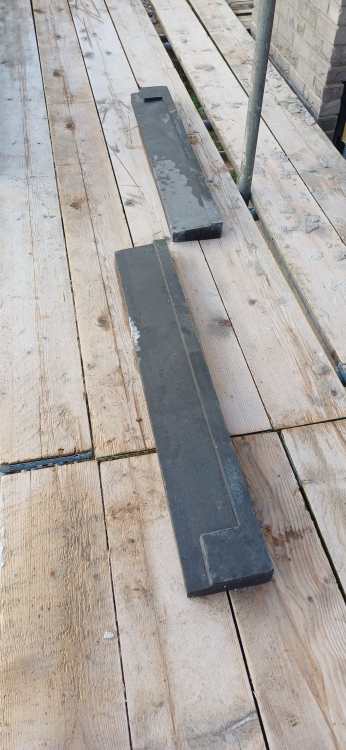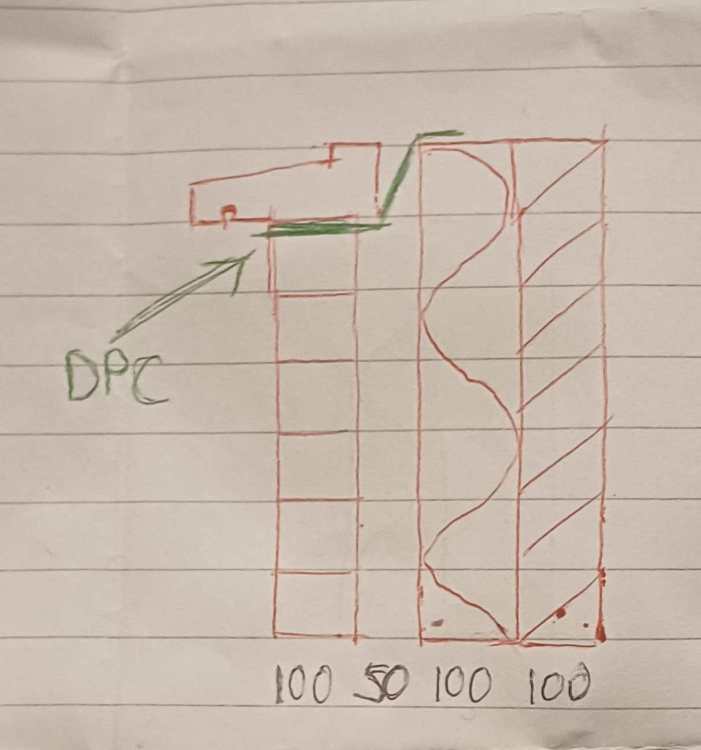
ruggers
Members-
Posts
312 -
Joined
-
Last visited
Personal Information
-
Location
NW England
Recent Profile Visitors
The recent visitors block is disabled and is not being shown to other users.
ruggers's Achievements

Regular Member (4/5)
20
Reputation
-
-
@Oz07 Thats what I was thinking but I wanted to see what others have done in case I'm missing something. The water cant get into the house because theres an open cavity gap.
-
As in 125 underneath the cill, up the back of it and then back over the top where the UPVC frame and cill sit over the cast stone? Any idea what the benefit of an external cill tray as opposed to just having 100mm DPC under the stone cill? My rear windows won't have stone cills , they'll be UPVC frame and cills direct onto the brick work with DPC or stepped tray underneath. It just feels like a stepped tray is going to prevent water escaping since theres no weep vents on a cill course where as a window lintel has weep vents every 450 horizontally.
-
The cast stone company won't provide details, they just produce them only and leave it up to the builders. I discussed two methods of installing cills I seen regularly and they said everyone has their own preference. This is what makes me unsure about the stepped DPC, because any water finding its way in from the outside into the cavity won't have anywhere to go, so it will just remain damp against the plastic tray. Why is a stepped tray needed when below the cill is open cavity, or a window head with cavity tray and weep vents? I have some expansion foam left from the brickwork, looks around 8 to 10mm thick but its knowing how far to set it down between the centre joint with them being in 2 parts and colour matching mortar pointed between them. I didn't know there was another option other than just using 85mm stub cill with a 70mm frame, The stone cill raised section is 40mm to bed the upvc cill onto with the frames fixed using window straps.
-
I thought of doing this it might limited the in coming air flow but could be better than nothing. What do the tiles or slates rest on, the over facia vent on the sub facia, and then the top of the capping board finishes in line with top of sub fascia?
-
I'm about to have my cast stone stooled cills fitted into the face brick exterior wall and I need to know if it's best to use 100mm DPC underneath, or a larger stepped DPC. What are the benefits if any of the stepped DPC as per my sketch? My partial fill cavity wall is 100 face brick, 50mm air gap, 100mm PIR, 100mm block. The cills are 65mm in height x 175mm deep so that i can have them set back into the cavity by 25mm, which then allows the windows to do the same. Rear of stone cill to front outer face of PIR=25mm. I planned to install a trimmed cavity closer under the cill, so a stepped angled DPC would interfere with this unless folded at 90 degrees.
-
@lookseehear hi, thanks for the detail. I don't think it works because the idea of the tilt fillet is to keep the slates right at the eaves to prevent them dropping, and to aldo mean the weight of the eaves course is on the timber fillet and not on the upvc facia. Adding the over fascia vent then puts the weight back onto the fascia rendering the tilt fillet useless unless I'm missing something obvious.
-
Thanks, I'd looked at this one the other day. I'll order some after ive checked the merchanta proce. Just wanted to check i was getting the good stuff and not wasting my time. Definitely won't be using it for any crimes @SteamyTea, some people are just evil.
-
Which brick acid is best for cleaning up any mortar residue off brick faces. Ive seen a few advertised as brick and patio cleaners but I'm wondering if they're too weak and i require a proper acid to dilute down. My bricks are new and are light grey. I have a few area where the rain caught it before it fully set, whether thats efflorescence or not?
-
Whats the best way to secure a 200mm horizontal soffit board and a fascia to 400 centre trusses. The rafters are 35mm wide and 150mm long on the untrimmed plum cut ends. Would I be better off installing a 150 x 25mm treated sub facia then add 18mm fascia or capping board over it for a better finish and more secure? I have 205mm soffit detail on the horizontal runs plus the gable ends. The soffit will butt up against the outer of the facing bricks as theres 2 courses of brick over the window lintels. What are my options to fix the soffit too? Would I screw a horizontal 4x2 to the side of each rafter 205mm long and then nail the facia into these? Or, fix a vertical 4x2 to the rafter with it up against the facing brick to nail the soffit into? This would mean nailing into end grain which isn't as strong.
-
What are my options for to vent my cold loft at the eaves end of the roof? I'm installing slates on my self build roof 35 pitch. 200 soffit. The ridge doesn't have to be vented but I'm looking to install a different ridge tile to the traditional vented ridge with visible rubber spacers. Because I'm installing MVHR which is going in the loft, I'm looking for as much air movement as possible for the summer heat build up. https://mayanroofingsystems.com/system/ridge/all-in-one/ I'm installing anthracite UPVC soffit and fascia and know that there vented soffit boards, but are there other options? I'd prefer not to have the weight of the slates bearing onto the fascia so a tilt fillet is likely to be used which rules out over fascia vents. I'd image continuous vented soffits attract a lot of dirt because my current white ones with circular vents are filthy every 2 years.
-
Thats a hell of a lot of screws per board compared to them guides showing 3 vs my builders none. I was thinking if both sides are screwed down too early, it would make it very difficult to get the next row t&g fit together and that it may be better to connect the next row in before screwing down each side of the newly glued joint. But this would mean once you start the job you have to keep going otherwise your screwing down boards that have set glue if the working time is 30 mins.
-
So thats one on every joists 0, 600, 1200, 1800, 2400. Assuming the 1200 and 1800 fixings, your fitting them on the opposite side to the 0 and 2400 ones but only after the 2nd row t&g are fitted to make it easier to pair them up and not be over clamped
-
How many srews did you put in a 2400 x 600 board? My guide shows 3 per sheet i thought it was 6. Ive 90 boards to lay.
-
Can you elaborate on the partially threaded screw so i can look for some. Not quite understanding why it would jack up? I thought 22mm boards would require a small pilot to get the screw started easier as they're quite hard but ive never used my impact gun on them. Nothing worse than cursing screws that wont start and end up with the driver head slipping into the fingers 😂 I had been looking at 4.0 x 60mm. Ill be laying them next week if its dry then exposed for 4 to 6 weeks. They are 60 day boards, no peel off, anti slip and protected both sides. @LaChab After you posted the Egger fitting guide, i looked for a krono fastshield one and it also tells you to fix the board on all 4 corners and 2 in the middle so I've no idea why their tech support said to just glue only. @Gone West what tape did you use, any old duct tape? kb-fast-shield-fitting-guide-final.pdf


